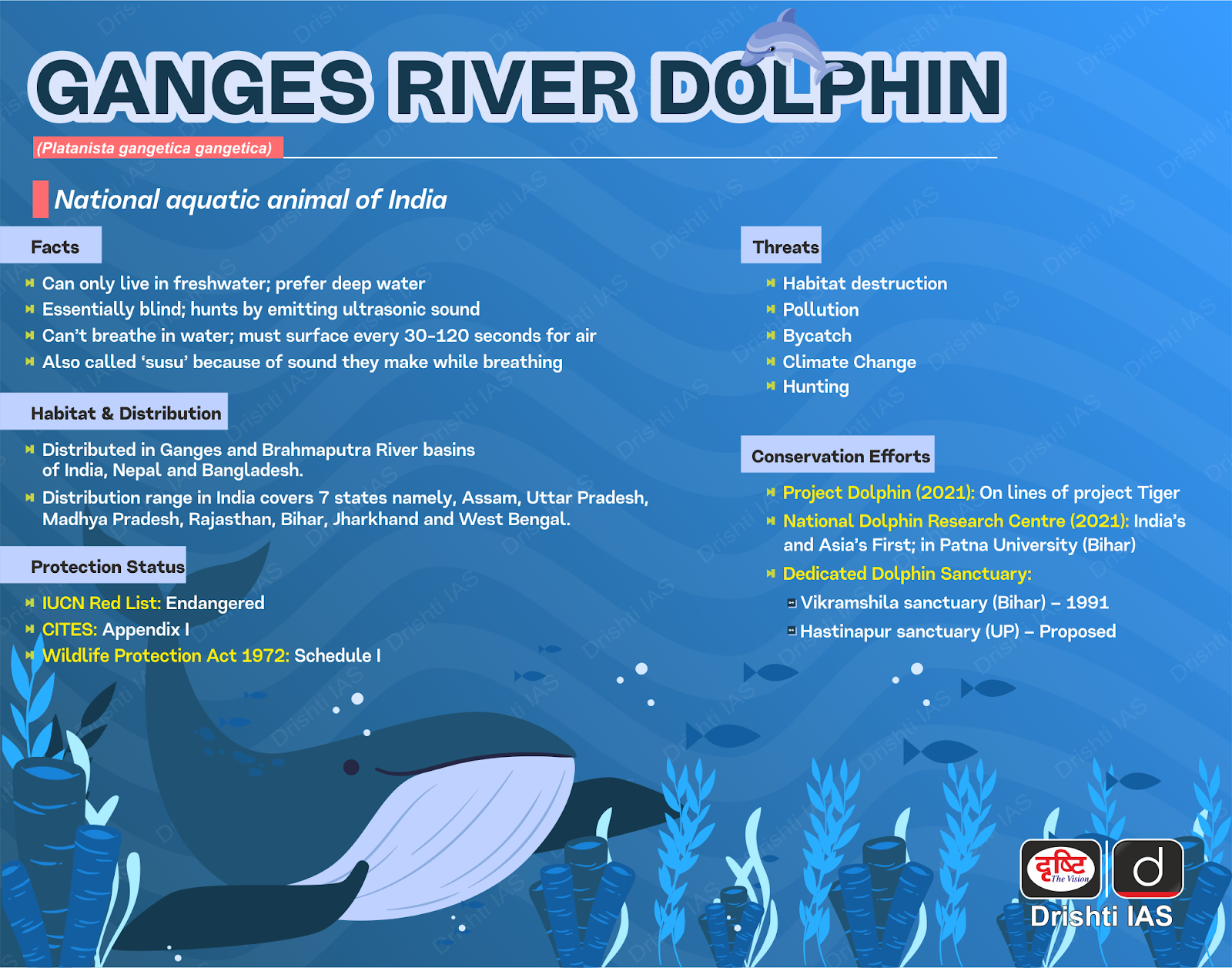Important Facts For Prelims
Global Declaration for River Dolphins
- 06 Nov 2023
- 4 min read
Why in News?
Recently, 11 Asian and South American countries signed a landmark deal in Bogota, Colombia to save the world’s six surviving species of river dolphins from extinction.
- This landmark deal signifies a ray of hope in combating the severe decline of river dolphin populations, which have dwindled by a staggering 73% since the 1980s.
What is the Global Declaration for River Dolphins?
- About:
- The Global Declaration for River Dolphins aims to halt the decline of all river dolphin species and bolster the most vulnerable populations through concerted efforts.
- It outlines measures such as eradicating gillnets, reducing pollution, expanding research initiatives, and creating protected areas to safeguard the remaining river dolphin species.
- Countries that adopted the declaration include: Bangladesh, Bolivia, Brazil, Cambodia, Colombia, Ecuador, India, Nepal, Pakistan, Peru, and Venezuela.
- There was also a representative from the regional government in Indonesia that has responsibility for the Mahakam river.
- The Global Declaration for River Dolphins aims to halt the decline of all river dolphin species and bolster the most vulnerable populations through concerted efforts.
- Foundational Pillars:
- The eight foundational pillars of the Global Declaration for River Dolphins comprise initiatives like establishing a network of protected areas, improving river dolphin site management, expanding research and monitoring efforts, engaging local communities and Indigenous Peoples, eradicating unsustainable fishing practices, enhancing water quality and quantity, promoting World River Dolphin Day (24th October) to raise awareness, and augment resource allocation and partnerships.
What are the Key Facts Associated with River Dolphins?
- About:
- River dolphins are a group of freshwater cetaceans that inhabit various river systems across Asia and South America.
- The Six Surviving River Dolphin Species include: Amazon, Ganges, Indus, Irrawaddy, Tucuxi, and the Yangtze finless porpoise.
- The Chinese river dolphin was deemed 'probably extinct' in 2007.
- As per the IUCN Red list, Yangtze finless porpoise are classified as Critically Endangered.
- Amazon, Ganges, Indus, Irrawaddy and Tucuxi are labeled as Endangered.
Note
The Yangtze finless porpoise is the world’s only freshwater porpoise but it is included with the other freshwater cetaceans under the umbrella name ‘river dolphins’.
- The Amazon river dolphin, also known as the pink river dolphin or boto is the largest river dolphin.
- Challenges Faced by River Dolphins:
- River dolphins are threatened by diverse factors, including unsustainable fishing practices, hydropower dam construction, pollution from various industries, agriculture, and mining, as well as habitat loss.
- Also, the recent tragic deaths of over 150 river dolphins in the drought-stricken Lake Tefe in the Amazon illustrate how climate change poses an increasingly severe threat to their survival.
- Successful Conservation Efforts:
- Conservation efforts in populated river basins like the Indus and Yangtze have seen success.
- For instance, the Indus river dolphin population in Pakistan doubled due to joint stakeholder action.
- Additionally, the Yangtze finless porpoises witnessed a 23% increase in numbers owing to protective measures.
- Moreover, the World Wildlife Fund's electronic pinger project saved 80 dolphins in Indonesia's Mahakam river from gill net entanglement.
- Conservation efforts in populated river basins like the Indus and Yangtze have seen success.
UPSC Civil Services Examination, Previous Year Question
Q. Which one of the following is the national aquatic animal of India? (2015)
(a) Saltwater crocodile
(b) Olive ridley turtle
(c) Gangetic dolphin
(d) Gharial
Ans: (c)








